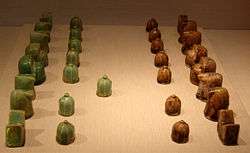Islamic Golden Age
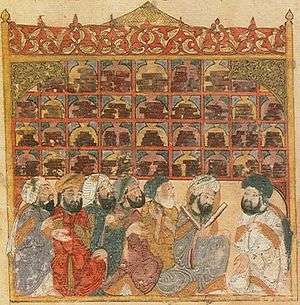
The Islamic Golden Age refers to a period in the history of Islam, traditionally dated from the 8th century to the 13th century, during which much of the historically Islamic world was ruled by various caliphates and science, economic development and cultural works flourished.[1][2][3] This period is traditionally understood to have begun during the reign of the Abbasid caliph Harun al-Rashid (786 to 809) with the inauguration of the House of Wisdom in Baghdad, where scholars from various parts of the world with different cultural backgrounds were mandated to gather and translate all of the world's classical knowledge into the Arabic language.[4][5] This period is traditionally said to have ended with the collapse of the Abbasid caliphate due to Mongol invasions and the Sack of Baghdad in 1258 AD.[6] A few contemporary scholars place the end of the Islamic Golden Age as late as the end of 15th to 16th centuries.[1][2][3]
History of the concept

The metaphor of a golden age began to be applied in 19th-century literature about Islamic history, in the context of the western aesthetic fashion known as Orientalism. The author of a Handbook for Travelers in Syria and Palestine in 1868 observed that the most beautiful mosques of Damascus were "like Mohammedanism itself, now rapidly decaying" and relics of "the golden age of Islam". [7]
There is no unambiguous definition of term, and depending on whether it is used with a focus on cultural or on military achievement, it may be taken to refer to rather disparate time spans. Thus, one author would have it extend to the duration of the caliphate, or to "six and a half centuries",[8] while another would have it end after only a few decades of Rashidun conquests, with the death of Umar and the First Fitna.[9]
During the early 20th century, the term was used only occasionally, and often referred to the early military successes of the Rashidun caliphs. It was only in the second half of the 20th century that the term came to be used with any frequency, now mostly referring to the cultural flourishing of science and mathematics under the caliphate during the 9th to 11th centuries (between the establishment of organised scholarship in the House of Wisdom and the beginning of the crusades),[10] but often extended to include part of the late 8th or the 12th to early 13th centuries.[11] Definitions may still vary considerably. Equating the end of the golden age with the end of the caliphate is a convenient cut-off point based on a historical landmark, but it can be argued that Islamic culture had entered a gradual decline much earlier; thus, Khan (2003) identifies the proper golden age as being the two centuries between 750–950, arguing that the beginning loss of territories under Harun al-Rashid worsened after the death of al-Ma'mun in 833, and that the crusades in the 12th century resulted in a further weakening of the Abbasid empire from which it never recovered.[12]
Causes
Religious influence
The various Quranic injunctions and Hadith, which place values on education and emphasize the importance of acquiring knowledge, played a vital role in influencing the Muslims of this age in their search for knowledge and the development of the body of science.[13][14][15]
Earlier cultural influence
During this period, the Muslims showed a strong interest in assimilating the scientific knowledge of the civilizations that had been conquered. Many classic works of antiquity that might otherwise have been lost were translated first from Sanskrit, under the influence of the Barmakids, and later from Greek, Persian, Chinese, Egyptian, and Phoenician civilizations into Arabic and Persian, and later in turn translated into Turkish, Hebrew, and Latin.[5]
Christians (particularly Nestorian Christians) and Hindus contributed to the Arab Islamic Civilization during the Ummayad and the Abbasid periods by translating works of Syriac and Indian philosophers and afterwards to Arabic.[16]
Government sponsorship
The Muslim government heavily patronized scholars. The money spent on the Translation Movement for some translations is estimated to be equivalent to about twice the annual research budget of the United Kingdom’s Medical Research Council.[17] The best scholars and notable translators, such as Hunayn ibn Ishaq, had salaries that are estimated to be the equivalent of professional athletes today.[17] The House of Wisdom was a library, translation institute, and academy established in Abbasid-era Baghdad, Iraq by Caliph Harun al-Rashid and his son al-Ma'mun.[18][19]
New technology
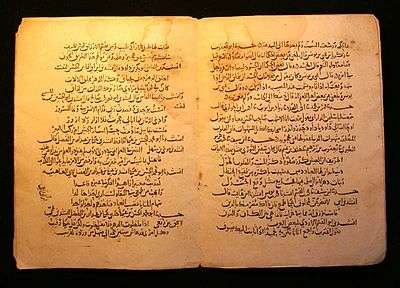
With a new and easier writing system, and the introduction of paper, information was democratized to the extent that, for probably the first time in history, it became possible to make a living from simply writing and selling books.[20] The use of paper spread from China into Muslim regions in the eighth century, arriving in Al-Andalus on the Iberian peninsula, present-day Spain in the 10th century. It was easier to manufacture than parchment, less likely to crack than papyrus, and could absorb ink, making it difficult to erase and ideal for keeping records. Islamic paper makers devised assembly-line methods of hand-copying manuscripts to turn out editions far larger than any available in Europe for centuries.[21] It was from these countries that the rest of the world learned to make paper from linen.[22]
Philosophy
Ibn Rushd and Ibn Sina played a major role in saving the works of Aristotle, whose ideas came to dominate the non-religious thought of the Christian and Muslim worlds. Ibn Sina and other philosophers such as al-Kindi and al-Farabi combined Aristotelianism and Neoplatonism with other ideas introduced through Islam. Arabic philosophic literature was translated into Latin and Ladino, contributing to the development of modern European philosophy. During this period, non-Muslims were allowed to flourish relative to treatment of religious minorities in the Christian Byzantine Empire. The Jewish philosopher Moses Maimonides, who lived in Andalusia, is an example.
Avicenna argued his "Floating Man" thought experiment concerning self-awareness, in which a man prevented of sense experience by being blindfolded and free falling would still be aware of his existence.[23]
In epistemology, Ibn Tufail wrote the novel Hayy ibn Yaqdhan and in response Ibn al-Nafis wrote the novel Theologus Autodidactus. Both were concerning autodidacticism as illuminated through the life of a feral child spontaneously generated in a cave on a desert island.
Mathematics
Algebra
Muḥammad ibn Mūsā al-Khwārizmī played a significant role in the development of algebra, algorithms, and Hindu-Arabic numerals.
Geometry
Islamic art makes use of geometric patterns and symmetries in many of its art forms, notably in girih tilings. These are formed using a set of five tile shapes, namely a regular decagon, an elongated hexagon, a bow tie, a rhombus, and a regular pentagon. All the sides of these tiles have the same length; and all their angles are multiples of 36° (π/5 radians), offering fivefold and tenfold symmetries. The tiles are decorated with strapwork lines (girih), generally more visible than the tile boundaries. In 2007, the physicists Peter Lu and Paul Steinhardt argued that girih from the 15th century resembled quasicrystalline Penrose tilings.[24][25][26][27] Elaborate geometric zellige tilework is a distinctive element in Moroccan architecture.[28] Muqarnas vaults are three-dimensional but were designed in two dimensions with drawings of geometrical cells.[29]
Trigonometry

Ibn Muʿādh al-Jayyānī is one of several Islamic mathematicians to whom the law of sines is attributed; he wrote his The Book of Unknown Arcs of a Sphere in the 11th century. This formula relates the lengths of the sides of any triangle, rather than only right triangles, to the sines of its angles.[30] According to the law,
where a, b, and c are the lengths of the sides of a triangle, and A, B, and C are the opposite angles (see figure).
Calculus
Alhazen discovered the sum formula for the fourth power, using a method that could be generally used to determine the sum for any integral power. He used this to find the volume of a paraboloid. He could find the integral formula for any polynomial without having developed a general formula.[31]
Science
Scientific method
Ibn Al-Haytham (Alhazen) was a significant figure in the history of scientific method, particularly in his approach to experimentation,[32][33][34][35] and has been described as the "world's first true scientist".[36]
Avicenna made rules for testing the effectiveness of drugs, including that the effect produced by the experimental drug should be seen constantly or after many repetitions, to be counted.[37] The physician Rhazes was an early proponent of experimental medicine and recommended using control for clinical research. He said: "If you want to study the effect of bloodletting on a condition, divide the patients into two groups, perform bloodletting only on one group, watch both, and compare the results."[38]
Jim Al-Khalili gives the example of the classification of materials as a sign of new ways of thinking.[39] While the classification of the material world by the ancient Indians and Greeks into Air, Earth, Fire and Water was more philosophical, medieval Islamic scientists used practical, experimental observation to classify materials.[39] Rhazes, for example, classified minerals into six groups based on their observed chemical properties: Spirits, which were flammable, Material Bodies, which were shiny and malleable, Salts, which could dissolve in water, Vitriols, Stones,and Boraxes.[39]
Astronomy
In about 964 AD, the Persian astronomer Abd al-Rahman al-Sufi, writing in his Book of Fixed Stars, described a "nebulous spot" in the Andromeda constellation, the first definitive reference to what we now know is the Andromeda Galaxy, the nearest spiral galaxy to our galaxy.[40]
Nasir al-Din al-Tusi invented a geometrical technique called a Tusi-couple, which generates linear motion from the sum of two circular motions to replace Ptolemy's problematic equant[41] The Tusi couple was later employed in Ibn al-Shatir's geocentric model and Nicolaus Copernicus' heliocentric Copernican model[42] although it is not known who the intermediary is or if Copernicus rediscovered the technique independently.
Optics
Alhazen played a significant role in the development of optics, experimental physics, and theoretical physics.
Chemistry
Al-Kindi warned against alchemists attempting the transmutation of simple, base metals into precious ones like gold in the ninth century.[37][43]
Anatomy
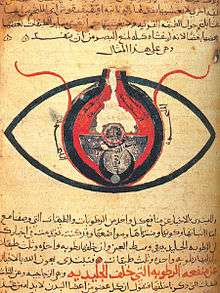
In the cardiovascular system, Ibn al-Nafis in his Commentary on Anatomy in Avicenna's Canon was the first to contradict the contention of the Galen School that blood could pass between the ventricles in the heart through the cardiac inter-ventricular septum that separates them, saying that there is no passage between the ventricles at this point.[44] Instead, he correctly argued that all the blood that reached the left ventricle did so after passing through the lung.[44] He also stated that there must be small communications, or pores, between the pulmonary artery and pulmonary vein, a prediction that preceded the discovery of the pulmonary capillaries of Marcello Malpighi by 400 years. The Commentary was rediscovered in the twentieth century in the Prussian State Library in Berlin; whether its view of the pulmonary circulation influenced scientists such as Michael Servetus is unclear.[44]
In the nervous system, Rhazes stated that nerves had motor or sensory functions, describing 7 cranial and 31 spinal cord nerves. He assigned a numerical order to the cranial nerves from the optic to the hypoglossal nerves. He classified the spinal nerves into 8 cervical, 12 thoracic, 5 lumbar, 3 sacral, and 3 coccygeal nerves. He used this to link clinical signs of injury to the corresponding location of lesions in the nervous system.[45]
Medicine
Rhazes differentiated through careful observation the two diseases smallpox and measles, which were previously lumped together as a single disease that caused rashes.[46] This was based on location and the time of the appearance of the symptoms and he also scaled the degree of severity and prognosis of infections according to the color and location of rashes.[47]
On hygienic practices, Rhazes, who was once asked to choose the site for a new hospital in Baghdad, suspended pieces of meat at various points around the city, and recommended building the hospital at the location where the meat putrefied most slowly.[38]
For Islamic scholars, Indian and Greek physicians and medical researchers Sushruta, Galen, Mankah, Atreya, Hippocrates, Charaka, and Agnivesa were pre-eminent authorities.[48] In order to make the Indian and Greek tradition more accessible, understandable, and teachable, Islamic scholars ordered and made more systematic the vast Indian and Greco-Roman medical knowledge by writing encyclopedias and summaries. Sometimes, past scholars were criticized, like Rhazes who criticized and refuted Galen's revered theories, most notably, the Theory of Humors and was thus accused of ignorance.[38] It was through 12th-century Arabic translations that medieval Europe rediscovered Hellenic medicine, including the works of Galen and Hippocrates, and discovered ancient Indian medicine, including the works of Sushruta and Charaka.[49][50] Works such as Avicenna's The Canon of Medicine were translated into Latin and disseminated throughout Europe. During the 15th and 16th centuries alone, The Canon of Medicine was published more than thirty-five times. It was used as a standard medical textbook through the 18th century in Europe.[51]
"Evolution"
Modern commentators have likened medieval accounts of the "struggle for existence" in the animal kingdom to the framework of the theory of evolution. Thus, in his survey of the history of the ideas which led to the theory of natural selection, Conway Zirkle noted that al-Jahiz was one of those who discussed a "struggle for existence", in his Kitab al-Hayawan (Book of Animals), written in the 9th century.[52] In the 13th century, Nasir al-Din al-Tusi believed that humans were derived from advanced animals, saying, "Such humans [probably anthropoid apes] live in the Western Sudan and other distant corners of the world. They are close to animals by their habits, deeds and behavior."[53] In 1377, Ibn Khaldun in his Muqaddimah stated, "“The animal kingdom was developed, its species multiplied, and in the gradual process of Creation, it ended in man & arising from the world of the monkeys.”[54]
Engineering
The Banū Mūsā brothers, in their Book of Ingenious Devices, describe an automatic flute player which may have been the first programmable machine.[55] The flute sounds were produced through hot steam and the user could adjust the device to various patterns so that they could get various sounds from it.[56]
Society
Social sciences
Ibn Khaldun is regarded to be among the founding fathers of modern sociology,[n 1] historiography, demography,[n 1] and economics.[57][n 2]
Healthcare
Hospitals in this era were the first to require medical diplomas to license doctors.[58] In the medieval Islamic world, hospitals were built in most major cities. The hospitals were typically run by a three-man board comprising a non-medical administrator, a physician who served as mutwalli (dean) and the shaykh saydalani, the chief pharmacist, who oversaw the dispensary.
By the ninth century, there was a rapid expansion of private pharmacies in many Muslim cities. Initially, these were unregulated and managed by personnel of inconsistent quality. Decrees by Caliphs Al-Ma'mun and Al-Mu'tasim required examinations to license pharmacists and pharmacy students were trained in a combination of classroom exercises coupled with day-to-day practical experiences with drugs. To avoid conflicts of interest, doctors were banned from owning or sharing ownership in a pharmacy. Pharmacies were periodically inspected by government inspectors called muhtasib, who checked to see that the medicines were mixed properly, not diluted and kept in clean jars. Violators were fined or beaten.[37]
Medical facilities traditionally closed each night, but by the 10th century laws were passed to keep hospitals open 24 hours a day, and hospitals were forbidden to turn away patients who were unable to pay.[59] Eventually, charitable foundations called waqfs were formed to support hospitals, as well as schools.[59] This money supported free medical care for all citizens.[59] In a notable example, a 13th-century governor of Egypt Al Mansur Qalawun ordained a foundation for the Qalawun hospital that would contain a mosque and a chapel, separate wards for different diseases, a library for doctors and a pharmacy.[60] The Qalawun hospital was based in a former Fatimid palace which had accommodation for 8,000 people - [61] "it served 4,000 patients daily."[62] The waqf stated,
"...The hospital shall keep all patients, men and women, until they are completely recovered. All costs are to be borne by the hospital whether the people come from afar or near, whether they are residents or foreigners, strong or weak, low or high, rich or poor, employed or unemployed, blind or sighted, physically or mentally ill, learned or illiterate. There are no conditions of consideration and payment, none is objected to or even indirectly hinted at for non-payment."[60]
Education
The Guinness World Records recognizes the University of Al Karaouine, founded in 859 AD, as the world's oldest degree-granting university.[63]
The Al-Azhar University was the first university in the East, and perhaps the oldest in history. The madrasa is one of the relics of the Fatimid dynasty era of Egypt, descended from Fatimah, daughter of Muhammad. Fatimah was called Az-Zahra (the brilliant), and it was named in her honor.[64] It was founded as a mosque by the Fatimid commander Jawhar, at the orders of the Caliph Al-Muizz as he founded the city for Cairo. It was (probably on Saturday) in Jamadi al-Awwal in the year 359 A.H. Its building was completed on the 9th of Ramadan in the year 361 A.H. Both Al-'Aziz Billah and Al-Hakim bi-Amr Allah added to its premises. It was further repaired, renovated, and extended by Al-Mustansir Billah and Al-Hafiz Li-Din-illah. Fatimid Caliphs always encouraged scholars and jurists to have their study-circles and gatherings in this mosque, and thus it was turned into a university. Al Azhar University now has the claim of being the oldest University still functioning.[65]
The intellectual life in Egypt during the Fatimid era reached a great degree of progress and activity due to the number of scholars who either lived in Egypt, or came from outside, as well as the number of books available. The Fatimid Caliphs gave prominent positions to the scholars in their courts and encouraged the students. Fatimids paid attention to establishing libraries in their palaces so that the scholars might polish up their knowledge and benefit from what their predecessors had done.[65]
Commerce and travel
Apart from the Nile, Tigris, and Euphrates, navigable rivers were uncommon in the Middle East, so transport by sea was very important. Navigational sciences were highly developed, making use of a rudimentary sextant (known as a kamal). When combined with detailed maps of the period, sailors were able to sail across oceans rather than skirt along the coast. Muslim sailors were also responsible for reintroducing large, three-masted merchant vessels to the Mediterranean. The name caravel may derive from an earlier Arab boat known as the qārib.[66]
Many Muslims went to China to trade, and these Muslims began to have a great economic impact and influence on the country. Muslims virtually dominated the import/export industry by the time of the Sung dynasty (960-1279).[67]
Freedom of expression
A significant feature of the Fatimid era were the freedoms given to the people and liberties given to the mind and reason. People could believe whatever they liked provided they did not infringe other's rights. The Fatimids reserved separate pulpits for different Islamic sects, and scholars expressed their ideas in whatever manner they pleased. The Fatimids gave patronage to scholars and invited them from every place, financially supported them, and ignored what they believed in, even when it went against Fatimid beliefs.[65][68]
Arts and culture
Poetry
The 13th century Persian poet Rumi wrote some of the finest Persian poetry and is still one of the best selling poets in America.[69][70]
Art

The golden age of Islamic art lasted from 750 to the 16th century, when ceramics (especially lusterware), glass, metalwork, textiles, illuminated manuscripts, and woodwork flourished. Manuscript illumination became an important and greatly respected art, and Persian miniature painting flourished in the Persianate world. Calligraphy, an essential aspect of written Arabic, developed in manuscripts and architectural decoration.
The Fatimid era was also known for their exquisite arts. A type of ceramic, lustreware, was prevalent during the Fatimid period. Glassware and metalworking was also popular.
Architecture
The Great Mosque of Kairouan (in Tunisia), the ancestor of all the mosques in the western Islamic world,[71] is one of the best preserved and most significant examples of early great mosques. Founded in 670, it dates in its present form largely from the 9th century.[72] The Great Mosque of Kairouan is constituted of a three-tiered square minaret, a large courtyard surrounded by colonnaded porticos, and a huge hypostyle prayer hall covered on its axis by two cupolas.[71]
The Great Mosque of Samarra in Iraq was completed in 847. It combined the hypostyle architecture of rows of columns supporting a flat base, above which a huge spiralling minaret was constructed.
The beginning of construction of the Great Mosque at Cordoba in 785 marked the beginning of Islamic architecture in Spain and Northern Africa. The mosque is noted for its striking interior arches. Moorish architecture reached its peak with the construction of the Alhambra, the magnificent palace/fortress of Granada, with its open and breezy interior spaces adorned in red, blue, and gold. The walls are decorated with stylized foliage motifs, Arabic inscriptions, and arabesque design work, with walls covered in geometrically patterned glazed tiles.
Many traces of Fatimid architecture exist in Cairo today, the most defining examples include the Al Azhar University and the Al Hakim mosque.
- Islamic architecture
-
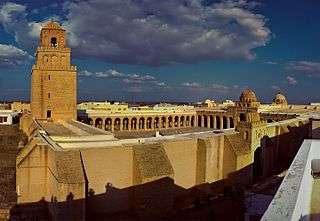
The Great Mosque of Kairouan, also known as the Mosque of Uqba, founded in 670, dates in its present state from the 9th century; one of the masterpieces of Islamic architecture.[1] Located in Kairouan, Tunisia.
-

Dome of the Treasury of the Great Mosque of Damascus, built in 789.
-
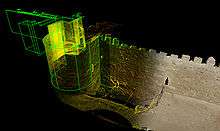
Laser scan data image of the Bab al-Barqiyya Gate in the 12th-century Ayyubid Wall. This fortified gate was constructed with interlocking volumes that surrounded the entrant to provide greater security and control than typical city wall gates.
-

Court of the Lions, Alhambra
-

The Al-Hakim Mosque in Cairo, of Al-Hakim bi-Amr Allah, the sixth Caliph, as renovated by Dawoodi Bohra
-
_2006.jpg)
The Al-Azhar Mosque, of medieval Islamic Cairo
- ^ Seyyed Hossein Nasr, ''Islamic art and spirituality''. SUNY Press. 1987-02-12. p. 53. ISBN 9780887061752. Retrieved 2014-04-11.
Role of Christians
Christians, especially the adherents of the Church of the East (Nestorians), contributed to Islamic civilization during the reign of the Ummayads and the Abbasids by translating works of Greek philosophers and ancient science to Syriac and afterwards to Arabic.[73] They also excelled in many fields, in particular philosophy, science (such as Hunayn ibn Ishaq,[74][75] Qusta ibn Luqa,[76] Masawaiyh,[77][78] Patriarch Eutychius,[79] and Jabril ibn Bukhtishu[80]) and theology. For a long period of time the personal physicians of the Abbasid Caliphs were often Assyrian Christians.[81][82] Among the most prominent Christian families to serve as physicians to the caliphs were the Bukhtishu dynasty.[83][84]
Throughout the 4th to 7th centuries, Christian scholarly work in the Greek and Syriac languages was either newly translated or had been preserved since the Hellenistic period. Among the prominent centers of learning and transmission of classical wisdom were Christian colleges such as the School of Nisibis[85] and the School of Edessa,[86] and the renowned hospital and medical academy of Jundishapur, which was the intellectual, theological and scientific center of the Church of the East.[87][88][89]
The House of Wisdom was founded in Baghdad in 825, modelled after the Academy of Gondishapur. It was led by Christian physician Hunayn ibn Ishaq, with the support of Byzantine medicine. Many of the most important philosophical and scientific works of the ancient world were translated, including the work of Galen, Hippocrates, Plato, Aristotle, Ptolemy and Archimedes. Many scholars of the House of Wisdom were of Christian background.[90]
Decline
Invasions
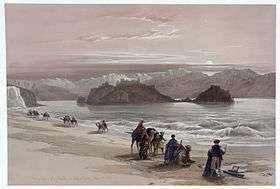
The Crusades put the Islamic world under pressure with invasions in the 11th and 12th centuries, but a far greater threat emerged from the East during the 13th century: in 1206, Genghis Khan established a powerful dynasty among the Mongols of central Asia. During the 13th century, this Mongol Empire conquered most of the Eurasian land mass, including China in the east and much of the old Islamic caliphate (as well as Kievan Rus) in the west. The destruction of Baghdad and the House of Wisdom by Hulagu Khan in 1258 has been seen by some as the end of the Islamic Golden Age.[91] Later Mongol leaders, such as Timur, destroyed many cities, slaughtered hundreds of thousands of people, and did irrevocable damage to the ancient irrigation systems of Mesopotamia. Muslims in lands subject to the Mongols now faced northeast, toward the land routes to China, rather than toward Mecca.
In the Iberian Peninsula, the Catholic Monarchs completed the Reconquista with a war against the Emirate of Granada that started in 1482 and ended with Granada's complete annexation in early 1492, which also marks, for some historians, the end of the Islamic Golden Age. The Ottoman conquest of the Arabic-speaking Middle East in 1516-17 placed the traditional heart of the Islamic world under Ottoman Turkish control. The rational sciences continued to flourish in the Middle East during the Ottoman period.[92]
Economics
To account for the decline of Islamic science, it has been argued that the Sunni Revival in the 11th and 12th centuries produced a series of institutional changes that decreased the relative payoff to producing scientific works. With the spread of madrasas and the greater influence of religious leaders, it became more lucrative to produce religious knowledge.[93]
Ahmad Y. al-Hassan has rejected the thesis that lack of creative thinking was a cause, arguing that science was always kept separate from religious argument; he instead analyzes the decline in terms of economic and political factors, drawing on the work of the 14th-century writer Ibn Khaldun. Al-Hassan extended the golden age up to the 16th century, noting that scientific activity continued to flourish up until then.[3] Several other contemporary scholars have also extended it to around the 16th to 17th centuries, and analysed the decline in terms of political and economic factors.[1][2] More recent research has challenged the notion that it underwent decline even at that time, citing a revival of works produced on rational scientific topics during the seventeenth century.[94][95]
See also
- Golden age of Jewish culture in Spain
- Ibn Sina Academy of Medieval Medicine and Sciences
- Islamic astronomy
- Islamic studies
- List of Iranian scientists
- Ophthalmology in medieval Islam
- Timeline of Islamic science and technology
- Christian influences in Islam
- Emirate of Sicily
Notes
- 1 2
- "...regarded by some Westerners as the true father of historiography and sociology".[96]
- "Ibn Khaldun has been claimed the forerunner of a great number of European thinkers, mostly sociologists, historians, and philosophers".(Boulakia 1971)
- "The founding father of Eastern Sociology".[97]
- "This grand scheme to find a new science of society makes him the forerunner of many of the eighteenth and nineteenth centuries system-builders such as Vico, Comte and Marx." "As one of the early founders of the social sciences...".[98]
- ↑
- "He is considered by some as a father of modern economics, or at least a major forerunner. The Western world recognizes Khaldun as the father of sociology but hesitates in recognizing him as a great economist who laid its very foundations. He was the first to systematically analyze the functioning of an economy, the importance of technology, specialization and foreign trade in economic surplus and the role of government and its stabilization policies to increase output and employment. Moreover, he dealt with the problem of optimum taxation, minimum government services, incentives, institutional framework, law and order, expectations, production, and the theory of value".Cosma, Sorinel (2009). "Ibn Khaldun's Economic Thinking". Ovidius University Annals of Economics (Ovidius University Press) XIV:52–57
References
- 1 2 3 George Saliba (1994), A History of Arabic Astronomy: Planetary Theories During the Golden Age of Islam, pp. 245, 250, 256–7. New York University Press, ISBN 0-8147-8023-7.
- 1 2 3 King, David A. (1983). "The Astronomy of the Mamluks". Isis. 74: 531–555. doi:10.1086/353360.
- 1 2 3 Hassan, Ahmad Y (1996). "Factors Behind the Decline of Islamic Science After the Sixteenth Century". In Sharifah Shifa Al-Attas. Islam and the Challenge of Modernity, Proceedings of the Inaugural Symposium on Islam and the Challenge of Modernity: Historical and Contemporary Contexts, Kuala Lumpur, August 1–5, 1994. International Institute of Islamic Thought and Civilization (ISTAC). pp. 351–399. Archived from the original on 2 April 2015.
- ↑ Medieval India, NCERT, ISBN 81-7450-395-1
- 1 2 Vartan Gregorian, "Islam: A Mosaic, Not a Monolith", Brookings Institution Press, 2003, pg 26–38 ISBN 0-8157-3283-X
- ↑ Islamic Radicalism and Multicultural Politics. Taylor & Francis. 2011-03-01. p. 9. ISBN 978-1-136-95960-8. Retrieved 26 August 2012.
- ↑ Josias Leslie Porter, A Handbook for Travelers in Syria and Palestine, 1868, p. 49.
- ↑ "For six centuries and a half, through the golden age of Islam, lasted this Caliphate, till extinguished by the Osmanli sultans and in the death of the last of the blood of the house of Mahomet. The true Caliphate ended with the fall of Bagdad". New Outlook, Volume 45, 1892, p. 370.
- ↑ "the golden age of Islam, as Mr. Gilman points out, ended with Omar, the second of the Kalifs." The Literary World, Volume 36, 1887, p. 308.
- ↑ "The Ninth, Tenth and Eleventh centuries were the golden age of Islam" LIFE magazine, 9 May 1955, p.74.
- ↑ so Linda S. George, The Golden Age of Islam, 1998: "from the last years of the eighth century to the thirteenth century."
- ↑ Arshad Khan, Islam, Muslims, and America: Understanding the Basis of Their Conflict, 2003, p. 19.
- ↑ Groth, Hans, ed. (2012). Population Dynamics in Muslim Countries: Assembling the Jigsaw. Springer Science & Business Media. p. 45. ISBN 9783642278815.
- ↑ Rafiabadi, Hamid Naseem, ed. (2007). Challenges to Religions and Islam: A Study of Muslim Movements, Personalities, Issues and Trends, Part 1. Sarup & Sons. p. 1141. ISBN 9788176257329.
- ↑ Salam, Abdus. Renaissance of Sciences in Islamic Countries. p. 9.
- ↑ Nestorian: CHRISTIAN SECT, "Nestorian scholars played a prominent role in the formation of Arab culture, and patriarchs occasionally gained influence with rulers. For more than three centuries the church prospered under the Caliphate, but it became worldly and lost leadership in the cultural sphere". Nestorian at Encyclopedia Britannica
- 1 2 "In Our Time - Al-Kindi,James Montgomery". bbcnews.com. 28 June 2012. Retrieved May 18, 2013.
- ↑ Hyman and Walsh Philosophy in the Middle Ages Indianapolis, 3rd edition, p. 216
- ↑ Meri, Josef W. and Jere L. Bacharach, Editors, Medieval Islamic Civilization Vol.1, A - K, Index, 2006, p. 451
- ↑ "In Our Time - Al-Kindi,Hugh Kennedy". bbcnews.com. 28 June 2012. Retrieved May 18, 2013.
- ↑ "Islam's Gift of Paper to the West". Web.utk.edu. 2001-12-29. Retrieved 2014-04-11.
- ↑ Kevin M. Dunn, ''Caveman chemistry : 28 projects, from the creation of fire to the production of plastics''. Universal-Publishers. 2003. p. 166. ISBN 9781581125665. Retrieved 2014-04-11.
- ↑ "In Our Time: Existence". bbcnews.com. 8 November 2007. Retrieved 27 March 2013.
- ↑ Peter J. Lu; Paul J. Steinhardt (2007). "Decagonal and Quasi-crystalline Tilings in Medieval Islamic Architecture". Science. 315 (5815): 1106–1110. Bibcode:2007Sci...315.1106L. doi:10.1126/science.1135491. PMID 17322056.
- ↑ "Advanced geometry of Islamic art". bbcnews.com. 23 February 2007. Retrieved July 26, 2013.
- ↑ "Islamic tiles reveal sophisticated maths". nature.com. 22 February 2007. Retrieved July 26, 2013. "Although they were probably unaware of the mathematical properties and consequences of the construction rule they devised, they did end up with something that would lead to what we understand today to be a quasi-crystal."
- ↑ "Nobel goes to scientist who knocked down 'Berlin Wall' of chemistry". cnn.com. 16 October 2011. Retrieved July 26, 2013.
- ↑ Castera, Jean Marc; Peuriot, Francoise (1999). Arabesques. Decorative Art in Morocco. Art Creation Realisation. ISBN 978-2-86770-124-5.
- ↑ van den Hoeven, Saskia, van der Veen, Maartje. "Muqarnas-Mathematics in Islamic Arts" (PDF). Archived from the original (PDF) on 27 September 2013. Retrieved 15 January 2016.
- ↑ "Abu Abd Allah Muhammad ibn Muadh Al-Jayyani". University of St.Andrews. Retrieved 27 July 2013.
- ↑ Katz, Victor J. (1995). "Ideas of Calculus in Islam and India". Mathematics Magazine. 68 (3): 163–174. doi:10.2307/2691411. JSTOR 2691411. [165–9, 173–4]
- ↑ El-Bizri, Nader, "A Philosophical Perspective on Ibn al-Haytham's Optics", Arabic Sciences and Philosophy 15 (2005-08-05), 189–218
- ↑ Haq, Syed (2009). "Science in Islam". Oxford Dictionary of the Middle Ages. ISSN 1703-7603. Retrieved 2014-10-22.
- ↑ Sabra, A. I. (1989). The Optics of Ibn al-Haytham. Books I–II–III: On Direct Vision. London: The Warburg Institute, University of London. pp. 25–29. ISBN 0-85481-072-2.
- ↑ Toomer, G. J. (1964). "Review: Ibn al-Haythams Weg zur Physik by Matthias Schramm". Isis. 55 (4): 463–465. doi:10.1086/349914.
- ↑ Al-Khalili, Jim (2009-01-04). "BBC News". BBC News. Retrieved 2014-04-11.
- 1 2 3 "The Islamic roots of modern pharmacy". aramcoworld.com. Retrieved 2016-05-28.
- 1 2 3 Hajar, R (2013). "The Air of History (Part IV): Great Muslim Physicians Al Rhazes". Heart Views. 14: 93–5. doi:10.4103/1995-705X.115499. PMC 3752886
 . PMID 23983918.
. PMID 23983918. - 1 2 3 Science and Islam, Jim Al-Khalili. BBC, 2009
- ↑ Henbest, N.; Couper, H. (1994). The guide to the galaxy. p. 31. ISBN 978-0-521-45882-5.
- ↑ Craig G. Fraser, 'The cosmos: a historical perspective', Greenwood Publishing Group, 2006 p.39
- ↑ George Saliba, 'Revisiting the Astronomical Contacts Between the World of Islam and Renaissance Europe: The Byzantine Connection', 'The occult sciences in Byzantium', 2006, p.368
- ↑ Felix Klein-Frank (2001) Al-Kindi. In Oliver Leaman & Hossein Nasr. History of Islamic Philosophy. London: Routledge. page 174
- 1 2 3 West, John (2008). "Ibn al-Nafis, the pulmonary circulation, and the Islamic Golden Age". Journal of Applied Physiology. 105 (6): 1877–80. doi:10.1152/japplphysiol.91171.2008. PMC 2612469
 . PMID 18845773. Retrieved 28 May 2014.
. PMID 18845773. Retrieved 28 May 2014. - ↑ Souayah, N; Greenstein, JI (2005). "Insights into neurologic localization by Rhazes, a medieval Islamic physician". Neurology. National Institutes of Health. 65: 125–8. doi:10.1212/01.wnl.0000167603.94026.ee. PMID 16009898.
- ↑ "Abu Bakr Mohammad Ibn Zakariya al-Razi (Rhazes) (c. 865-925)". sciencemuseum.org.uk. Retrieved May 31, 2015.
- ↑ "Rhazes Diagnostic Differentiation of Smallpox and Measles". ircmj.com. Retrieved May 31, 2015.
- ↑ Cyril Elgood, A Medical History of Persia and the Eastern Caliphate, (Cambridge University Press, 1951), p.3.
- ↑ K. Mangathayaru. Pharmacognosy: An Indian perspective. Pearson education. p. 54.
- ↑ Lock, Stephen (2001). The Oxford Illustrated Companion to Medicine. Oxford University Press. p. 607. ISBN 0-19-262950-6.
- ↑ A.C. Brown, Jonathan (2014). Misquoting Muhammad: The Challenge and Choices of Interpreting the Prophet's Legacy. Oneworld Publications. p. 12. ISBN 978-1780744209.
- ↑ Zirkle, Conway (25 April 1941). "Natural Selection before the "Origin of Species"". Proceedings of the American Philosophical Society. 84 (1): 71–123. JSTOR 984852.
- ↑ Farid Alakbarov (Summer 2001). A 13th-Century Darwin? Tusi's Views on Evolution, Azerbaijan International 9 (2).
- ↑ "Rediscovering Arabic Science". Saudi Aramco Magazine. Retrieved 13 July 2016.
- ↑ Koetsier, Teun (2001), "On the prehistory of programmable machines: musical automata, looms, calculators", Mechanism and Machine Theory, Elsevier, 36 (5): 589–603, doi:10.1016/S0094-114X(01)00005-2.
- ↑ Banu Musa (authors), Donald Routledge Hill (translator) (1979), The book of ingenious devices (Kitāb al-ḥiyal), Springer, pp. 76–7, ISBN 90-277-0833-9
- ↑
- Joseph J. Spengler (1964). "Economic Thought of Islam: Ibn Khaldun", Comparative Studies in Society and History, 6(3), pp. 268-306 JSTOR 177577 .
• Jean David C. Boulakia (1971). "Ibn Khaldûn: A Fourteenth-Century Economist", Journal of Political Economy, 79(5), pp. 1105–1118 JSTOR 1830276.
- Joseph J. Spengler (1964). "Economic Thought of Islam: Ibn Khaldun", Comparative Studies in Society and History, 6(3), pp. 268-306 JSTOR 177577 .
- ↑ Alatas, Syed Farid (2006). "From Jami'ah to University: Multiculturalism and Christian–Muslim Dialogue". Current Sociology. 54 (1): 112–32. doi:10.1177/0011392106058837.
- 1 2 3 Rise and spread of Islam. Gale. 2002. p. 419. ISBN 9780787645038.
- 1 2 Philip Adler; Randall Pouwels (2007). World Civilizations. Cengage Learning. p. 198. ISBN 9781111810566. Retrieved 1 June 2014.
- ↑ Bedi N. Şehsuvaroǧlu. "Bīmāristān". In P. Bearman; Th. Bianquis; C.E. Bosworth; et al. Encyclopaedia of Islam (2nd ed.). Retrieved 5 June 2014.
- ↑ Mohammad Amin Rodini (7 July 2012). "Medical Care in Islamic Tradition During the Middle Ages" (PDF). International Journal of Medicine and Molecular Medicine. Retrieved 9 June 2014.
- ↑ The Guinness Book Of Records, Published 1998, ISBN 0-553-57895-2, P.242
- ↑ Halm, Heinz. The Fatimids and their Traditions of Learning. London: The Institute of Ismaili Studies and I.B. Tauris. 1997.
- 1 2 3 Shorter Shi'ite Encyclopaedia, By: Hasan al-Amin, http://www.imamreza.net/eng/imamreza.php?id=574
- ↑ "History of the caravel". Nautarch.tamu.edu. Retrieved 2011-04-13.
- ↑ "Islam in China". bbcnews.com. 2 October 2002. Retrieved 13 July 2016.
- ↑ https://books.google.com/books?id=inYASgAACAAJ&dq=shi%27ite+encyclopedia+al+amin&focus=searchwithinvolume&q=freedom+expression
- ↑ Haviland, Charles (2007-09-30). "The roar of Rumi - 800 years on". BBC News. Retrieved 2011-08-10.
- ↑ "Islam: Jalaluddin Rumi". BBC. 2009-09-01. Retrieved 2011-08-10.
- 1 2 John Stothoff Badeau and John Richard Hayes, ''The Genius of Arab civilization: source of Renaissance''. Taylor & Francis. 1983-01-01. p. 104. ISBN 9780262081368. Retrieved 2014-04-11.
- ↑ "Great Mosque of Kairouan (Qantara mediterranean heritage)". Qantara-med.org. Retrieved 2014-04-11.
- ↑ Hill, Donald. Islamic Science and Engineering. 1993. Edinburgh Univ. Press. ISBN 0-7486-0455-3, p.4
- ↑ Rashed, Roshdi (2015). Classical Mathematics from Al-Khwarizmi to Descartes. Routledge. p. 33. ISBN 0-415-83388-4.
- ↑ Ḥunayn ibn Isḥāq
- ↑ Nancy G. Siraisi, Medicine and the Italian Universities, 1250–1600 (Brill Academic Publishers, 2001), p 134.
- ↑ Beeston, Alfred Felix Landon (1983). Arabic literature to the end of the Umayyad period. Cambridge University Press. p. 501. ISBN 978-0-521-24015-4. Retrieved 20 January 2011.
- ↑ "Compendium of Medical Texts by Mesue, with Additional Writings by Various Authors". World Digital Library. Retrieved 2014-03-01.
- ↑ Griffith, Sidney H. (15 December 1998). "Eutychius of Alexandria". Encyclopædia Iranica. Retrieved 2011-02-07.
- ↑ Anna Contadini, 'A Bestiary Tale: Text and Image of the Unicorn in the Kitāb naʿt al-hayawān (British Library, or. 2784)', Muqarnas, 20 (2003), 17-33 (p. 17), JSTOR 1523325.
- ↑ Bonner, Bonner; Ener, Mine; Singer, Amy (2003). Poverty and charity in Middle Eastern contexts. SUNY Press. p. 97. ISBN 978-0-7914-5737-5.
- ↑ Ruano, Eloy Benito; Burgos, Manuel Espadas (1992). 17e Congrès international des sciences historiques: Madrid, du 26 août au 2 septembre 1990. Comité international des sciences historiques. p. 527. ISBN 978-84-600-8154-8.
- ↑ Rémi Brague, Assyrians contributions to the Islamic civilization
- ↑ Britannica, Nestorian
- ↑ Foster, John (1939). The Church of the T'ang Dynasty. Great Britain: Society for Promoting Christian Knowledge. p. 31.
The school was twice closed, in 431 and 489
- ↑ The School of Edessa, Nestorian.org.
- ↑ University of Tehran Overview/Historical Events
- ↑ Kaser, Karl The Balkans and the Near East: Introduction to a Shared History p. 135.
- ↑ Yazberdiyev, Dr. Almaz Libraries of Ancient Merv Dr. Yazberdiyev is Director of the Library of the Academy of Sciences of Turkmenistan, Ashgabat.
- ↑ Hyman and Walsh Philosophy in the Middle Ages Indianapolis, 1973, p. 204' Meri, Josef W. and Jere L. Bacharach, Editors, Medieval Islamic Civilization Vol.1, A-K, Index, 2006, p. 304.
- ↑ William Wager Cooper and Piyu Yue (2008), ''Challenges of the Muslim world: present, future and past'', Emerald Group Publishing, page 215. 2008. ISBN 9780444532435. Retrieved 2014-04-11.
- ↑ El-Rouhayeb, Khaled (2015). Islamic Intellectual History in the Seventeenth Century: Scholarly Currents in the Ottoman Empire and the Maghreb. Cambridge: Cambridge University Press. pp. 1–10. ISBN 978-1-107-04296-4.
- ↑ "Religion and the Rise and Fall of Islamic Science". scholar.harvard.edu. Retrieved 2015-12-20.
- ↑ El-Rouayheb, Khaled (2008). "The Myth of "The Triumph of Fanaticism" in the Seventeenth-Century Ottoman Empire". Die Welt des Islams. 48: 196–221.
- ↑ El-Rouayheb, Khaled (2006). "Opening the Gate of Verification: The Forgotten Arab-Islamic Florescence of the 17th Century". International Journal of Middle East Studies. 38: 263–281.
- ↑ Gates, Warren E. (1967). "The Spread of Ibn Khaldûn's Ideas on Climate and Culture". Journal of the History of Ideas. University of Pennsylvania Press. 28 (3): 415–422. doi:10.2307/2708627.
- ↑ Dhaouadi, M. (1 September 1990). "IBN KHALDUN: THE FOUNDING FATHER OF EASTERN SOCIOLOGY". International Sociology. 5 (3): 319–335. doi:10.1177/026858090005003007.
- ↑ Haddad, L. (1 May 1977). "A FOURTEENTH-CENTURY THEORY OF ECONOMIC GROWTH AND DEVELOPMENT". Kyklos. 30 (2): 195–213. doi:10.1111/j.1467-6435.1977.tb02006.x.
Further reading
- Josef W. Meri (2005). Medieval Islamic Civilization: An Encyclopedia. Routledge. ISBN 0-415-96690-6. pp. 1088.
- Tamara Sonn: Islam: A Brief History. Wiley 2011, ISBN 9781444358988, pp. 39–79 (online copy, p. 39, at Google Books)
- Maurice Lombard: The Golden Age of Islam. American Elsevier 1975
- George Nicholas Atiyeh; John Richard Hayes (1992). The Genius of Arab Civilization. New York University Press. ISBN 0814734855, ISBN 9780814734858. pp. 306.
- Falagas, M. E.; Zarkadoulia, Effie A.; Samonis, George (1 August 2006). "Arab science in the golden age (750-1258 C.E.) and today". The FASEB Journal. 20 (10): 1581–1586. doi:10.1096/fj.06-0803ufm. PMID 16873881.
- Allsen, Thomas T. (2004). Culture and Conquest in Mongol Eurasia. Cambridge University Press. ISBN 978-0521602709.
External links
| Wikimedia Commons has media related to Islamic Golden Age. |
- Islamic web
- Wiet, Gaston. "Baghdad: Metropolis of the Abbasid Caliphate." Chapter 5
- The Kirkor Minassian Collection at the Library of Congress contains examples of Islamic book bindings.

